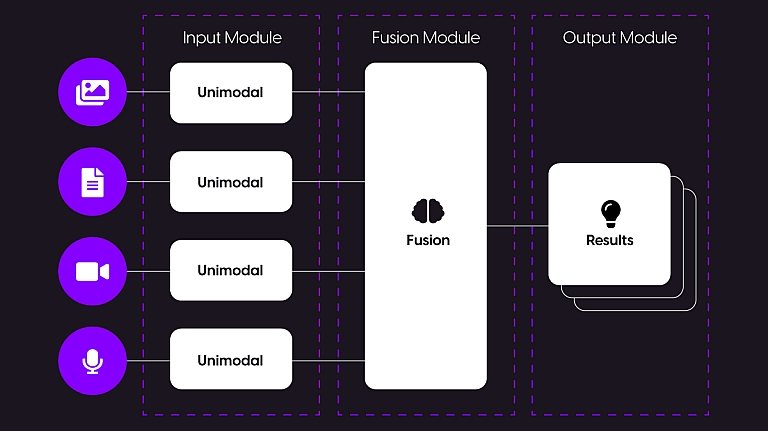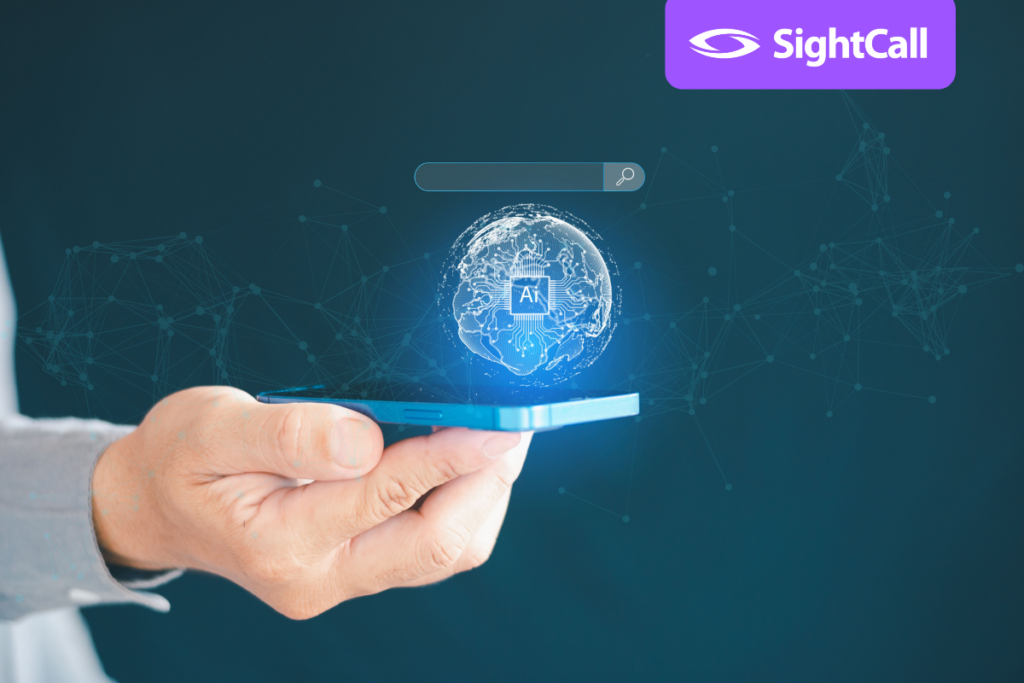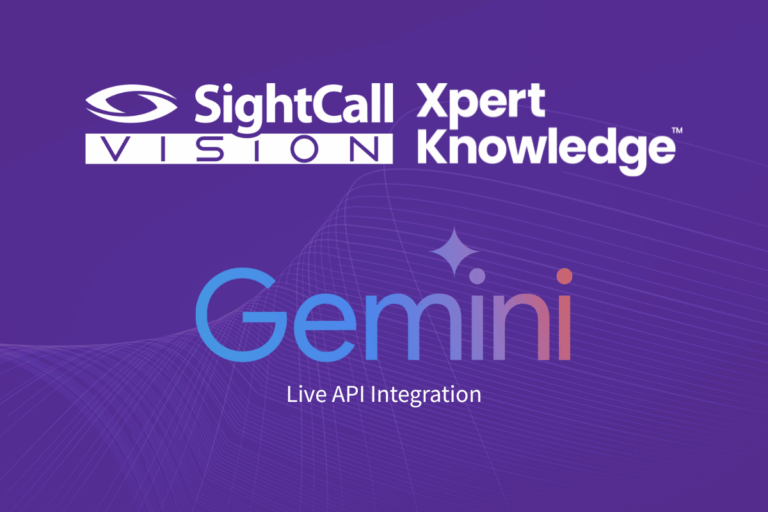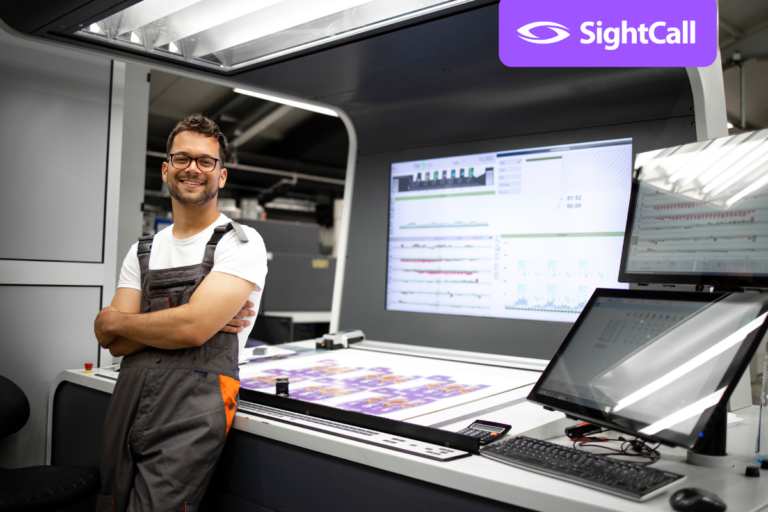It’s hard to avoid the topic of AI in conversation these days.
By now, you’ve probably encountered or used generative AI tools in your professional or personal life.
You may have observed that many of these tools are limited in the kinds of data they can process and the outputs they generate. From ChatGPT for text applications to Midjourney and DALL-E for images, most AI tools employ single-modal generative AI, which means they can manage only one data type—be it text, image, video, or audio.
But with the continuous evolution of technology, AI solutions are emerging that can manage multiple data types and sources simultaneously.
These solutions are known collectively as multimodal generative AI.

Multimodal Generative AI: Breaking it Down
Imagine a technology that perceives the world much like humans do, using multiple “senses” in conjunction with each other to perceive and understand the world.
Multimodal AI can combine and interpret multiple data inputs to create a more nuanced and humanlike understanding of the information presented to it.
This includes data (or modes) such as video, images, speech, sound, and text.
In essence, multimodal AI systems are composed of three main components.
-
Input Module: Contains a series of unimodal neural networks, each responsible for handling a specific modal data type.
-
Fusion Module: Combines and connects the data from the input module, using the strengths of each modality (text, images, video, audio) to create a comprehensive, structured data set.
-
Output Module: Generates the desired content in multimodal format, combining text, images, video, and audio to make predictions, decisions, or recommendations that a human can then use in the real world.
Multimodal generative AI isn’t just a fancy term. It’s bridging gaps that single-modal generative AI can’t, forging new avenues and opportunities for enterprise service organizations.
“Customer service is the second highest area seeing adoption of generative AI among businesses, just behind information technology.” – Gartner
Related Read: Generative AI & Customer Service: 9 Things Contact Center Leaders Need to Know

Multimodal Gen AI Applications in Enterprise Customer and Field Service Organizations
Generative AI is quickly emerging as a key enabler behind the scenes of many enterprise-level customer service operations. And companies are devising ways for multimodal AI to make delivering high-quality service easier.
Predictive Maintenance
Equipment failure can result in significant downtime, costly repairs, and production loss. Companies are exploring how predictive maintenance, with the advent of AI, can transform the industrial landscape.
For example, in the healthcare industry, hospitals rely on their equipment to be functional at a moment’s notice to ensure they can provide timely care to their patients.
From MRI machines to CT scanners to ventilators, health providers can’t afford to have their equipment unavailable when their patients’ health depends on it. Using systems powered by multimodal generative AI, diagnostic data from an equipment’s sensors can be collected and analyzed simultaneously.
The AI can correlate the information and predict potential issues, so hospitals can develop maintenance plans or equipment rotation schedules to ensure they are not hindered by device downtime.
By combining and analyzing data from different modalities, the AI offers a more comprehensive view of a machine’s health, enabling timely interventions. This not only reduces unplanned shutdowns, but also extends the lifespan of the equipment.
Personalized Customer Interactions
In the era of information overload, customers want interactions that feel unique to their preferences and needs.
Imagine a retail website where, based on your past shopping behavior, product views, and even uploaded photos of your personal style, an AI suggests outfits and products tailored just for you.
Soon enough, with multimodal generative AI, businesses will no longer be restricted to just analyzing textual data; they’ll be able to leverage visual information to refine their understanding of each customer’s preferences.
And this goes beyond just offering product recommendations. For instance, in the not too distant future, a user will be able to upload a picture of their living room, and the AI will suggest furniture and decor that matches the style and layout, creating an immersive and customized shopping experience.
Automated Customer Support
Customer service centers are no stranger to repetitive queries that take up time and energy.
By implementing multimodal AI solutions, service centers will be able to resolve common inquiries automatically. Simple customer problems get solved faster, freeing up agents to focus their attention on more complex issues.
Consider a scenario where a customer snaps a picture of a malfunctioning appliance and uploads it to a company’s service portal (along with a short description of the issue).
Instead of the usual back-and-forth textual interaction, AI instantly recognizes the faulty part and either prompts the customer with step-by-step instructions, offers a multimedia repair guide or facilitates the ordering of a replacement, all within minutes.
This solution expedites the support process and gets customers closer to a solution before ever connecting with a live agent.
“38% of businesses consider customer experience and retention to be the primary focus of their generative AI initiatives” – Gartner

Benefits of Multimodal Generative AI
The seamless integration of various communication channels and data types is in the early days but evolving rapidly. Multimodal Generative AI stands at the forefront of this transformation, offering tangible benefits to customer service departments and field service operations in large enterprises.
At SightCall, we are committed to helping our customers keep pace with rapid innovation. We think there are three primary advantages of integrating multimodal generative AI for your customer service and field service organizational practices:
1) Transformational Shifts in Customer Dynamics
The digital customer is evolving. In this complex landscape, they seek immediacy, precision, and relevance. With multimodal generative AI, customer service departments are uniquely poised to bridge this expectation gap.
It’s more than just solving problems; it’s about pre-empting them and crafting solutions that are tailor-made for each individual interaction.
Soon multimodal gen AI will be able to help resolve customer problems faster and more accurately, while also providing more natural and personalized interactions, whether with a support agent or with an AI chatbot directly. These improvements can enhance the user experience while also increasing customer satisfaction and loyalty.
2) The Cost-Benefit Paradigm
While the financial advantage of streamlining operations is evident, the less tangible – yet equally critical – benefit is the equity earned from demonstrating innovation leadership.
Every dollar saved is a testament to operational efficiency, but every satisfied customer is an ambassador in the making. The infusion of multimodal generative AI is not just about saving; it’s about investing in the future.
In addition, automating repetitive processes and solutions reduces the need for human agents to handle these simpler tasks. This allows businesses to reallocate their human labor resources more effectively to higher value work that is more professionally fulfilling.
3) Positioning for the Future
As services and products attract competitors and move toward commoditization, the differentiating factor will undeniably shift towards service excellence. By integrating multimodal generative AI, enterprises will be able to position themselves at the vanguard of this shift. It’s not about keeping up with the competition; it’s about redefining the playing field.
With the customer service landscape increasingly becoming driven by AI, integrating multimodal generative AI into your workflow will help your business stay ahead of the curve and give you a competitive edge compared to other companies in your industry.
“For service organizations that have adopted generative AI into their businesses, 54% reported seeing decreases in costs, and 57% reported seeing increases in revenue.” – McKinsey
Challenges and Considerations
As with all technology, multimodal generative AI has its inherent risks and challenges to consider when deciding whether to adopt it into a company’s business practices.
Some of these risks include potential data confidentiality breaches, data privacy and security issues, AI misrepresentations (hallucinations), copyright concerns, and potential misuse.
Despite these risks, 68% of IT executives believe that the benefits to be gained from generative AI outweigh its potential risks. (Gartner)
For visionary customer service departments, the pressing question isn’t whether to adopt generative AI, but when.
The nexus of technology and strategy is already here, as are the experts who are ready to help you navigate and implement multimodal data sets and generative AI systems.
By partnering with trusted AI technology leaders like SightCall, you and your company will be set up for sustained success in the decades to come.



